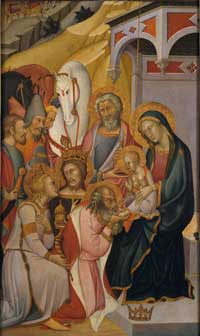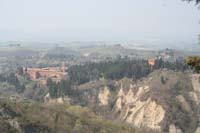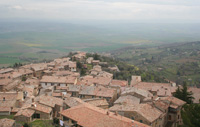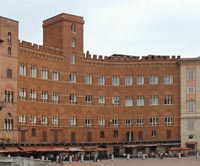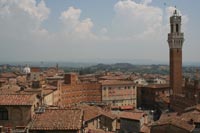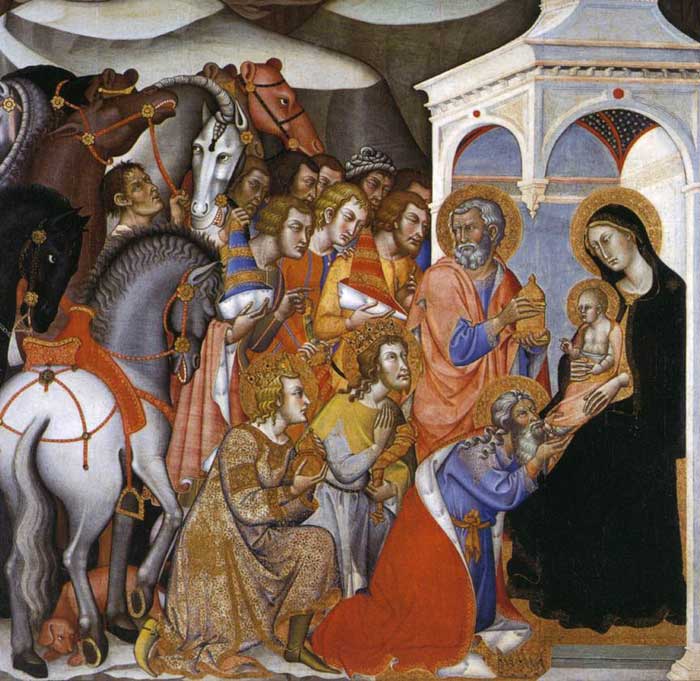 |
| Bartolo di Fredi, The Adoration of the Magi (detail), 1385-88, tempera on panel, 195 x 163 cm, Pinacoteca Nazionale, Siena |
Bartolo di Fredi | The Adoration of the Magi |
| Bartolo di Fredi was one of the most popular masters in Siena in the second half of the fourteenth centuryand produced numerous altarpieces and fresco cycles over a period of approximately fifty years. He maintained a large workshop. He was influenced by both Simone Martini and Pietro Lorenzetti, and following late Gothic inspirations he developed his style on this basis. He was a pupil of Ambrogio Lorenzetti. His best two fresco cycles are at San Gimignano, one dealing with Old Testament subjects in the Collegiata (1356) and one in the church of S. Agostino on the birth and death of the Virgin (1366).[1] He was the most successful Sienese painter of the later fourteenth century. He shared a workshop with Andrea Vanni, and produced a large number of altarpieces and frescoes, and, in addition, collaborated with other artists on mural and altarpiece paintings and polychrome sculptures. He worked on many of his most important commissions with his son, Andrea di Bartolo. There are three surviving fragments of Bartolo’s altarpiece. The smallest of the fragments, part of the predella, is in the University of Virginia collection, while a Crucifixion with adoring saints, which in fact adjoins it in the predella, is in the Lindenau-Museum. The central panel, which depicts the Adoration scene itself, is in Siena. 'There is no doubt that what remains of Bartolo’s altarpiece of the Magi is a beautiful and monumental work. In it his style appears to be eclectic, fusing simplicity in rendering the human form, which spread beyond Florence in the wake of Giotto and his followers, with Gothic linearism, which the old school of art historians would have considered retardataire. The depiction of the Magi themselves in some ways suggests Gothic manuscript illumination writ large.'.[2] |
The Adoration of the Magi |
||
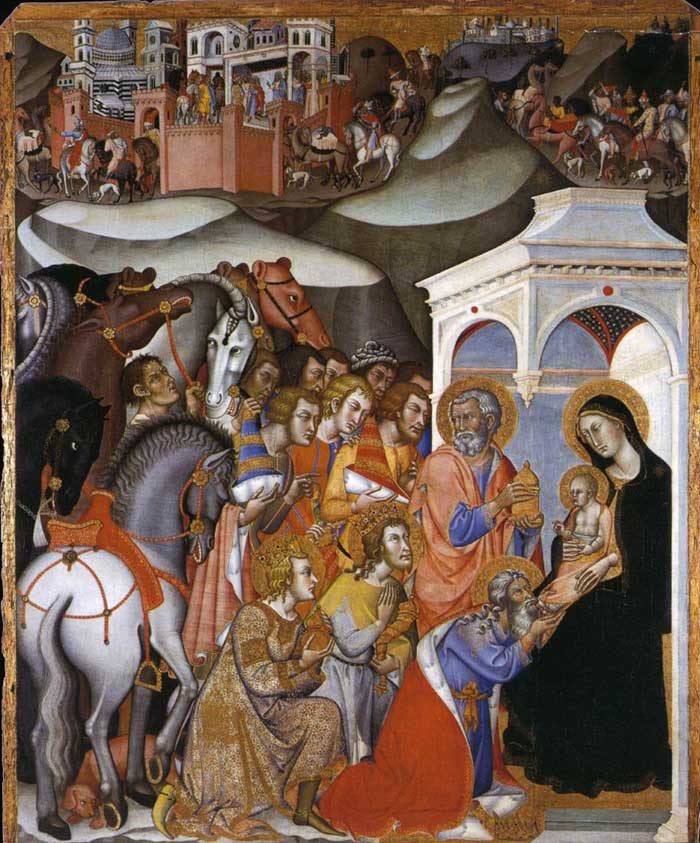 |
||
Bartolo di Fredi, The Adoration of the Magi, 1385-88, tempera on panel, 195 x 163 cm, Pinacoteca Nazionale, Siena |
||
This altarpiece The Adoration of the Magi was commissioned for the cathedral of Siena. |
||
|
||
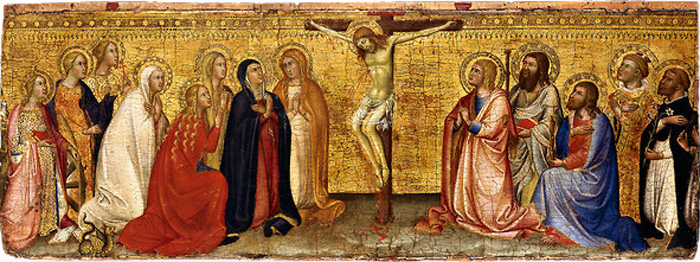 |
||
Bartolo di Fredi, The Adoration of the Crucifix, tempera and gold leaf on panel, Lindenau-Museum, Altenburg |
||
| The Adoration of the Magi in Siena is closely related to another depiction by the artist of the same subject, now in the Metropolitan Museum of Art in New York. Like the celebrated painting in Siena, this composition originally included the procession of the Magi in the upper zone. Two headless camels and the legs of two attendants and a dog in the upper left corner offer evidence of the once amplified narrative. A fragment of the upper panel is preserved in the Musée des Beaux-Arts, Dijon. Sorabella, Jean. "The Birth and Infancy of Christ in Italian Painting ". In Heilbrunn Timeline of Art History. New York: The Metropolitan Museum of Art, 2000. Kanter, Laurence B., and George Bisacca. "Italian Renaissance Frames". In Heilbrunn Timeline of Art History. New York: The Metropolitan Museum of Art, 2000–. http://www.metmuseum.org/toah/hd/fram/hd_fram.htm (October 2008) The Adoration of the Magi by Bartolo di Fredi: A Masterpiece Reconstructed, The Fralin Museum of Art at the University of Virginia, 2012, curated by Bruce Boucher | www.berkshirereview.newyorkarts.net Catalogue with essays by Bruce Boucher, Francesca Fiorani, Wolfgang Loseries, and Anna Maria Guiducci. The exhibition reunited the surviving components of a late medieval Sienese altarpiece that was arguably one of the greatest work of the painter Bartolo di Fredi (ca. 1330-1410): the main panel, which has remained in Siena since its completion around 1380, and portions of the predella from the Lindenau-Museum in Altenburg, Germany, and from University of Virginia Art Museum. Holland Cotter, Come Let Us Adore Him.‘The Adoration of the Magi’ at Museum of Biblical Art | New York Times, 9 August 2012 Art in Tuscany | The adoration of the magi |
||||
[1] The Collegiate Church, dedicated to Our Lady of the Assumption and situated on the west side of the Piazza del Duomo in San Gimignano, is one of the most important examples of Romanesque architecture in Tuscany. The church is both a sanctuary of faith and of art, since many of the works still present in the basilica or now in the town’s museums were made for devotional reasons or as ex-votos for grace received. Originally a simple baptismal church, in 1056 it was raised to a Provostry by Pope Victor II. Then in 1148, Pope Eugene III, traveling along the Via Francigena on his way back to Rome, consecrated it as a Collegiate Church. A papal bull emitted by Lucius III granted it numerous privileges, and in 1220 Pope Honorius III confirmed the prerogatives of the Chapter of Canons, as Pope Innocent IV did again in 1241. Work began in 1238 to enlarge and decorate the basilica, in which leading artists participated up through the seventeenth century. San Gimignano’s saints were venerated and had their feast days celebrated here: Saint Fina, Blessed Bartolo, Saint Peter Martyr, and Blessed Ciardo. The relic of Saint Geminianus, the bishop saint from Modena, is here, kept in an altar dedicated to him, and his feast day of January 31 is a town holiday. Fra Savonarola was among the many canons, Franciscans, Dominicans and Augustinians who preached from the pulpit of the basilica. |
||||
Holiday accomodation in Tuscany | Podere Santa Pia
|
||||
Podere Santa Pia |
Podere Santa Pia, garden view, April |
View from terrace with a stunning view over the Maremma and Montecristo |
||
Monte Oliveto Maggiore abbey |
San Gimignano |
Montalcino |
||
| Italian Painting of the Later Middle Ages Until the late eleventh century, southern Italy occupied the western border of the vast Byzantine empire. Even after this area fell under Norman rule in about 1071, Italy maintained a strong link with Byzantium through trade, and this link was expressed in the art of the period. Large illustrated Bibles ("giant Bibles") and Exultet Rolls—liturgical scrolls containing texts for the celebration of Easter, produced in the Benevento region of southern Italy—enjoyed great popularity from about 1050 onward. Miniature illustrations in the Bibles, which relate to contemporary monumental wall paintings produced in Rome, were strongly influenced by early Christian painting cycles from Roman churches. After the sack of Constantinople in 1204 by Christian armies of the Fourth Crusade, precious objects from Byzantium made their way to Italian soil and profoundly influenced the art produced there, especially the brightly colored gold-ground panels that proliferated during the thirteenth century. A Madonna and Child (60.173) by Berlinghiero, the foremost painter of the period working in the Tuscan city of Lucca, is one such example: in this panel, the Madonna gestures solemnly toward the infant Christ, depicted as a miniature adult, who wears a philosopher's robes and gestures in blessing. This composition is of the Byzantine type known as the Hodegetria, which may be translated as "One Who Shows the Way," as the Madonna points to Christ as the way to salvation. Starburst-like ornaments at the crown of the Madonna's head and on her right shoulder (a third would have appeared on her left shoulder, here concealed by the figure of Christ) are also traditional Byzantine motifs, symbolizing Mary's virginity before, during, and after the birth of Christ. At the end of the thirteenth century and beginning of the fourteenth, three great masters appeared who changed the course of painting: the Florentine Giotto di Bondone (1266/76–1337), the Roman Pietro Cavallini (ca. 1240–after ca. 1330), and the Sienese Duccio di Buoninsegna (active ca. 1278–1318). Giotto's figures are volumetric rather than linear, and the emotions they express are varied and convincingly human rather than stylized (11.126.1). He created a new kind of pictorial space with an almost measurable depth. With Giotto, the flat world of thirteenth-century Italian painting was transformed into an analogue for the real world, for which reason he is considered the father of modern European painting. Duccio, founder of the Sienese school of painting, brought a lyrical expressiveness and intense spiritual gravity to the formalized Italo-Byzantine tradition. In a small devotional panel of the Madonna and Child (2004.442), Duccio bridged the gap between the spiritual world of the figures and the real world of the viewer by means of an illusionistic parapet, among the first of its kind in Western painting. Other exceptional artists who painted during this period were Taddeo Gaddi (1997.117.1), Maso di Banco (43.98.13), Ambrogio and Pietro Lorenzetti (2002.436; 13.212), and Simone Martini (1975.1.12; 41.100.23). Simone Martini added an elegance and refinement to the spare form of Giotto's art. Pietro Lorenzetti, a pupil of Duccio, produced works innovative in their imaginative detail and expressive naturalism (2004.442). At the start of the fourteenth century, elements of the Gothic style that emerged in twelfth-century France began to appear in Italian painting: architectural motifs such as the pointed arch, a refined delicacy of detail, increased naturalism, and an emphasis on fluid form. By mid-century, a surge of artistic output concentrated in central Italy integrated new ideals into earlier modes of depiction. The Byzantine devotional image of the Galaktotrophousa, or Virgo Lactans, which depicts the Madonna nursing the Christ Child, achieves a new elegance in Sienese master Paolo di Giovanni Fei's sumptuously detailed panel (41.190.13). Bartolo di Fredi referred to pictorial traditions of both East and West in The Adoration of the Shepherds (25.120.288), in which the stable of Christ's nativity is set into a cave. The artist used this projecting structure to experiment with perspective and the conveyance of spatial depth. Fresco The bare wall was first dampened and coated with a layer of coarse lime plaster, called arriccio, on which the design was drawn or brushed in red earth pigment (sinopia). The overall composition was painted in sections known as giornate—Italian for "a day's work." Each of these sections was composed of a smooth plaster layer called intonaco. Pigments diluted in water were applied directly to the wet intonaco; as the plaster dried, a chemical reaction bound the pigment to it. Embellishments applied to a dry wall—fresco a secco (secco is the Italian word for dry)—are far less durable, as the paint tends to flake off over time. Fresco is vulnerable to moisture and may be damaged in a cool, damp environment; the arid Mediterranean climate is favorable for its preservation. The medium of fresco enabled artists to depict complex narratives, and to experiment with depth and spatial relationships. They were often painted in a series, or cycle, for a single space. Usually fresco cycles consisted of scenes from the life of Christ, the Virgin Mary, or the saint to whom a church or monastery was dedicated. Between 1253 and 1340, many of the outstanding artists of the period, including Cimabue and Giotto, contributed frescoes depicting episodes from the life of Saint Francis (1181–1226) to his basilica at Assisi. Chapels dedicated to other saints are part of the basilica. One, dedicated to Saint Martin of Tours, bears ten frescoes by Simone Martini, exquisite in their rich characterization, coloration, and detail. They are among the greatest examples of the Sienese master's oeuvre, and some of the finest frescoes produced in fourteenth-century Italy. About 1303, the Paduan nobleman Enrico Scrovegni commissioned Giotto, renowned as the greatest painter of his day, to fresco the Arena Chapel in Padua. In cycles depicting scenes from the Life of the Virgin and the Life of Christ, Giotto's naturalism, compositional clarity, and the volumetric, sculptural presence of his figures combine in scenes of unprecedented drama. These frescoes were widely praised for their innovation by Dante, Boccaccio, and Petrarch; along with Giotto's fresco cycles for the Bardi and Peruzzi chapels at Santa Croce in Florence—remarkable for their ambitious description of space and scale—they are masterworks that influenced two centuries of artists (1971.115.1ab). Panel Painting A seasoned plank — one that had been allowed to dry out for some time — was first layered with several coats of size, a glue made from animal skins. In Italy, the planks used for panel paintings were often made of native poplar, a widely available wood that was, however, soft and vulnerable to warping. A piece of linen soaked in size was often laid over the front of the panel to conceal any surface flaws. Over this, coats of gesso were applied. Gesso, a mixture of powdered calcium sulfate (commonly called gypsum) and animal glue, provided the ground for preliminary drawings. When the underdrawing was complete, the panel was ready for gilding. Areas to be gilded were prepared with a layer of bole, a reddish clay that provided an adhesive surface for fragile gold leaf. The gold leaf was made by pounding a small amount of gold into thin sheets, which were then applied to the panel using a tool called a gilder's tip. The gilded surface was rubbed with a hard-tipped instrument to smooth and polish the gold leaf, a process known as burnishing. Additional decoration could be incised or stamped into the surface using metal rods, called punches, with patterns cut into one end. The tip of the punch, placed against the panel and struck from the other end with a mallet, pressed the design into the wood. Punching was often used to achieve the intricately detailed haloes surrounding the heads of holy figures. Finally, the panel could be painted. Medieval artists used tempera paints, made by mixing ground pigments with egg yolk. This medium produces a brilliant, pure hue. Many paintings of this period have engaged frames made of wooden strips attached to the outside edge of the panel, some examples of which survive . Original frames may sometimes bear hinge marks, indicating that the work was once part of a diptych or triptych, designed to be closed. Independent panels were often used on private altars in a domestic setting. For large church altarpieces, it was necessary to join together independently painted panels with an elaborate frame. Usually, the Madonna and Child were shown on the main panels, flanked by saints and apostles, identifiable by their attributes. A strip of smaller panels—called the predella—at the bottom of the altarpiece depicted additional figures or narrative episodes from the life of Christ, Mary, or the saints.
|
||||
Siena, duomo |
Siena, Palazzo Sansedoni |
Siena, Piazza del Campo |
||
|
||||

